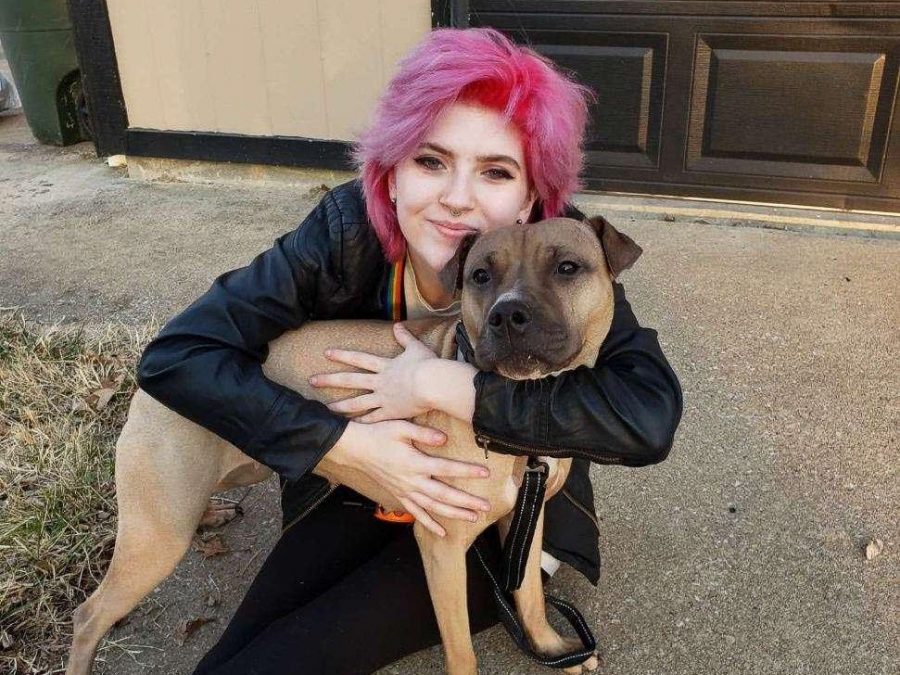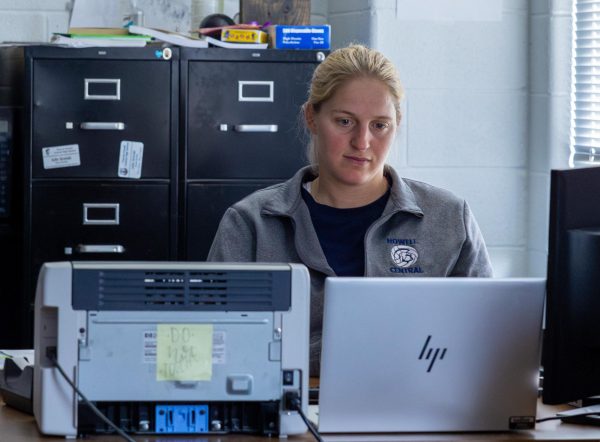A Huggable Lifeline
Understanding the assistance of a service dog
A MEDICAL LIFE-LINE: E Lanterman smiles as they hold their new service dog, Piper. For them, a service dog aids in supporting mental health and comfort.
Freshman E Lanterman walks through the hallway, a few minutes remaining before the bell rings. As they arrive at their next class, just like any other student, they eventually find their seat and begin their work as the bell rings. Beside the desk sits a dog, happily waiting for her cue to offer help.
“There’s a big difference between a medical dog and a [normal] dog….my dog is medical equipment,” Lanterman said.
Service dogs are typically given a minimum of 150 hours of training, covering basic task and obedience training, as well as specialized services and public access. That’s over half a year of training at the least. Lanterman’s previous dog, Piper, was a shar-pei pit mix, commonly used for their high sensitivity to emotions, and was the first dog to gain public access. Unfortunately, while in her trial period, the newness of the job and environment caused her to ‘wash out,’ and be returned home to her previous family.
Piper was a psychiatric service dog, used less for aid for physical needs and disabilities, and more to help alert the owner to specific situations and provide clarity amidst panic attacks.
“A dog is …the barrier between me saying ‘Just ignore it’…[It’s] a massive label, not only to [me], but to everyone around [me] that there’s a problem,” Lanterman said.
Piper was specifically trained to help with Lanterman’s struggles with severe panic and anxiety disorders, OCD, PTSD, and agoraphobia, whether it came in the form of helping lower their blood pressure, interrupting traumatic flashbacks, and grounding Lanterman through particularly intimidating moments.
Despite the constant presence of service dogs, they are trained to stay out of the way and work in any environment they may be in.
“My dog is literally trained to stay out of the way in all situations. She learns to sit under lunch tables, under desks, on top of my book bag … we sit in the back of classrooms or near the door … if she’s in your way, it’s because I’m in your way,” Lanterman said.
When you do see a service dog, it is important to remember that they should not be pet or touched without explicit permission from the owner.
“A vest should be treated like an invisibility cloak, ” Lanterman said.
Furthermore, if you have questions about service dogs and what is or is not allowed, ask the owner. Interfering with service animals in any way can be considered a misdemeanor and even felony, so it’s important to obtain permission and instruction when regarding service animals.
“Service dogs are a lifeline, and when you interrupt them, you break that lifeline,” Lanterman said.
Overall, Lanterman hopes to be able to reach out and clarify confusion and stigmas surrounding service dogs and disabilities.
“[I] very quickly learned how to be different and sort [my] way through a society that tells you to be black and white. But you know, we’re a box of crayons. Some people are gonna hate certain colors. You can’t change people’s feelings. You can just try and educate. So that’s what I do,” Lanterman said.
Your donation will support the student journalists of Francis Howell Central High School. Your contribution will allow us to purchase equipment and cover our annual website hosting costs. FHCToday.com and our subsequent publications are dedicated to the students by the students. We hope you consider donating to allow us to continue our mission of a connected and well-informed student body.











